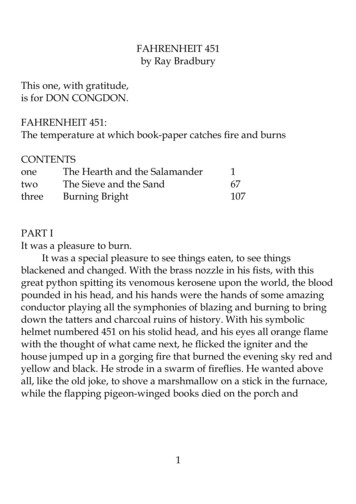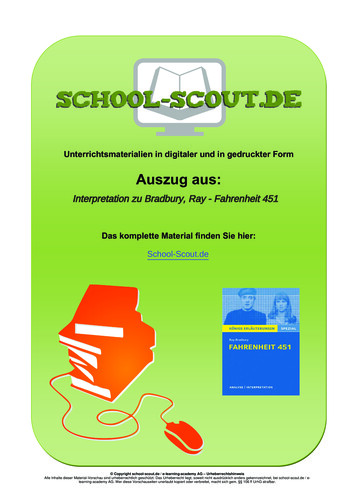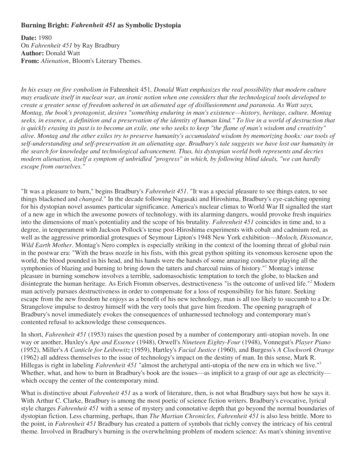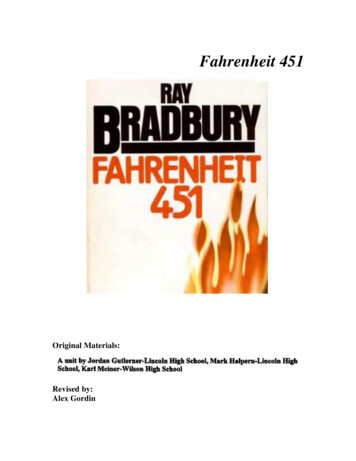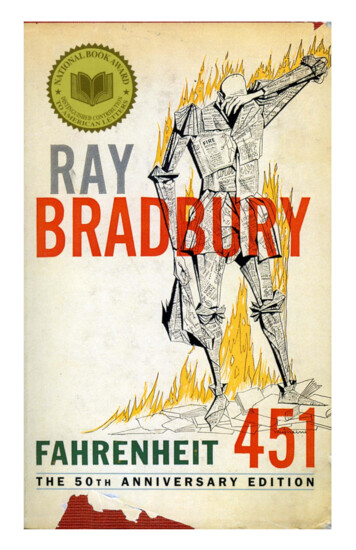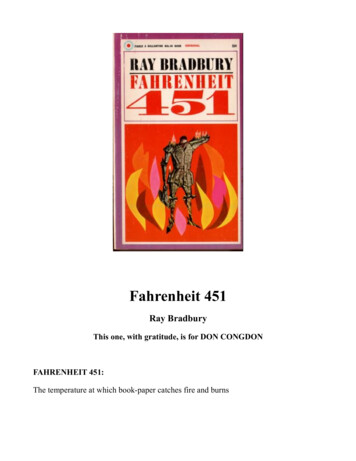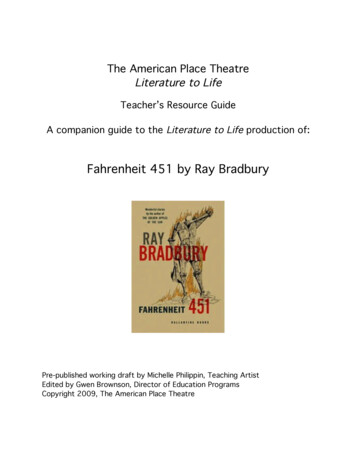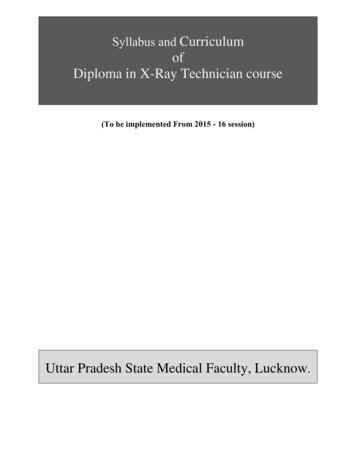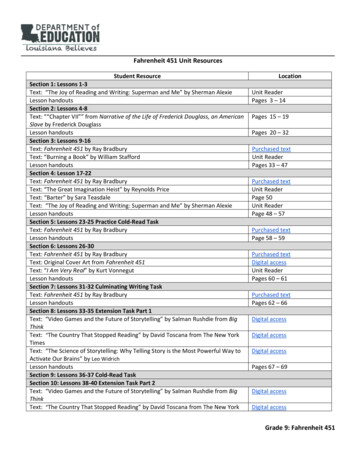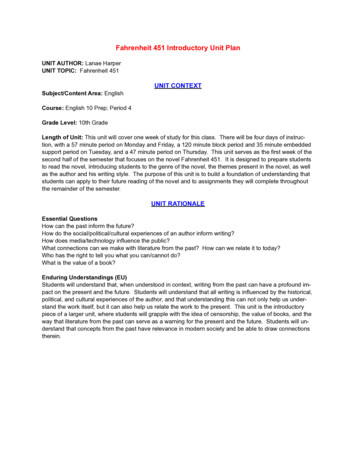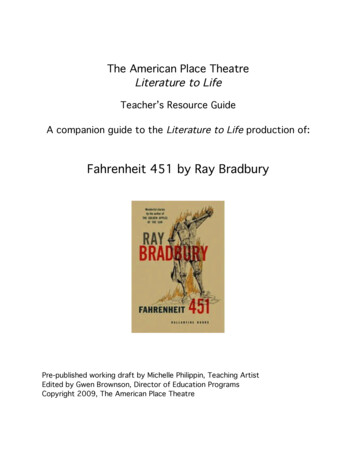
Transcription
The American Place TheatreLiterature to LifeTeacher’s Resource GuideA companion guide to the Literature to Life production of:Fahrenheit 451 by Ray BradburyPre-published working draft by Michelle Philippin, Teaching ArtistEdited by Gwen Brownson, Director of Education ProgramsCopyright 2009, The American Place Theatre
Literature to Life Educator’s Guide to PerformancesThank you for choosing Literature to Life to help enrich your students learningexperience and foster their understanding of great theatre and the power of thewritten word. Here at The American Place Theatre, we have a long history of bringinggreat writers to the stage, and we believe that teachers sharing this information withtheir students prior to attending a show will greatly maximize the theatrical experience.To that end, please review the following notes with your class before coming to thetheatre!What is different about a Literature to Life Production:A Literature to Life Performance is a verbatim theatrical adaptation of significantAmerican literature brought to life by a solo professional actor. Our shows are generallyperformed in small theatres, intimate settings where the audience is uniquely engagedwith the literary work. Due to the close quarters we perform in, it is crucial for teachersto review Theatre Etiquette with their students prior to seeing a show. Performanceincludes the following: 15-minute pre-show interactive discussion 1-hour performance (Actual length may vary slightly.) 15-minute post-show interactive discussion Teacher's Resource GuideWhat to do before AND after the performance:Follow this companion guide to find exercises that will both prepare your students forseeing the performance and will extend the learning after they’ve experienced theadaptation. The guide is divided into pre-show preparation exercises and post-showfollow-up exercises, although many will work interchangeably. These exercises shouldbe applicable whether or not your students have read the book— you may have tomodify some content for relevance.2
Pre- Show PreparationPre-Show Activity # 1: The Life and Times of Ray BradburyBookmark: Ray Bradbury & LiteratureObjectives: Students will familiarize themselves with the life and work of RayBradbury. The students will practice identifying key information in a piece oftext. They will explore their own dream careers and aspirations by writing theirown autobiographies from a projected eighty-year old first-person voice.Educational Standards Addressed:NYS ELA Standard 3: Performance Indicator- Understand that within anygroup there are many different points of view depending on the particularinterests and values of the individualNYS ELA Standard 2: Performance Indicator-Write stories/literary essaysthat observe the conventions of genre and contain interesting and effectivelanguage and voiceInstructions: Make copies of Ray Bradbury’s biography below—either byphotocopying this article, or cutting and pasting the biography into a WordDocument from http://www.raybradbury.com/bio.html. Distribute a copy of thisbiography to each student.Have the students take turns reading paragraphs of the biography aloud or readsilently to themselves. While listening/reading, the students should beinstructed to circle key information about the writer on their copy of the bio.Once the students have finished reading, ask the students a few focusingquestions such as:- What was Ray Bradbury’s first achievement as a writer?- Was he formally educated? How might education affect people’sperceptions of a writer’s work?- What might it mean to be a writer of “courage and vision?”- What does it say about Bradbury that he did not confine himself to onemedium/genre (novels, stories, screenplays) of work?- How does one measure their lifes’ achievements? Does that differ fromperson to person?3
- What sorts of achievements do you think were most meaningful to Bradburybased on his biography?Once the students have engaged in dialogue, have them take out writing paperor a notebook. Read aloud the following instructions: Close your eyes and takea deep breath. I want you to imagine your dream home. It doesn’t have to be amansion or anything fancy; it can be, but it could also be a cabin by a lake or anicely furnished apartment in a city. It can be clean or messy. It can be anythingyou want it to be. Now imagine that you’re sitting in your favorite chair in thathome, in front of a computer. You’re sitting at the keyboard, getting ready towrite the biography of your life. You are eighty years old. Very slowly I want youto move through those eighty years of life and think of what brought you tothat place, that dream home— and try answering the following questions(Educators, feel free to add/improvise your own/Teachers may post thequestions above on the board or chart paper so that the students have accessto them throughout the writing of their autobiographies):-What goals have you achieved?-What was your career/job?-Were you a leader in your field?-Were you married/Do you have any children?-Is there anything you wished you’d done that you haven’t yetaccomplished?-What sorts of awards or honors have you won?-What are you most proud of?Ray Bradbury, Biography4
Ray Bradbury, American novelist, short story writer, essayist, playwright, screenwriter and poet,was born August 22, 1920 in Waukegan, Illinois. He graduated from a Los Angeles high schoolin 1938. Although his formal education ended there, he became a "student of life," sellingnewspapers on L.A. street corners from 1938 to 1942, spending his nights in the public libraryand his days at the typewriter. He became a full-time writer in 1943, and contributed numerousshort stories to periodicals before publishing a collection of them, Dark Carnival, in 1947.His reputation as a writer of courage and vision was established with the publication of TheMartian Chronicles in 1950, which describes the first attempts of Earth people to conquer andcolonize Mars, and the unintended consequences. Next came The Illustrated Man and then, in1953, Fahrenheit 451, which many consider to be Bradbury's masterpiece, a scathing indictmentof censorship set in a future world where the written word is forbidden. In an attempt to salvagetheir history and culture, a group of rebels memorize entire works of literature and philosophy astheir books are burned by the totalitarian state.Ray Bradbury has never confined his vision to the purely literary. He has been nominated for anAcademy Award (for his animated film Icarus Montgolfier Wright), and has won an EmmyAward (for his teleplay of The Halloween Tree). He adapted sixty-five of his stories fortelevision's Ray Bradbury Theater. He was the creative consultant on the United States Pavilionat the 1964 New York World's Fair. In 1982 he created the interior metaphors for the SpaceshipEarth display at Epcot Center, Disney World, and later contributed to the conception of theOrbitron space ride at Euro-Disney, France.Married since 1947, Mr. Bradbury and his wife Maggie lived in Los Angeles with theirnumerous cats. Together, they raised four daughters and had eight grandchildren. Sadly, Maggiepassed away in November of 2003.On the occasion of his 80th birthday in August 2000, Bradbury said, "The great fun in my lifehas been getting up every morning and rushing to the typewriter because some new idea has hitme. The feeling I have every day is very much the same as it was when I was twelve. In anyevent, here I am, eighty years old, feeling no different, full of a great sense of joy, and glad forthe long life that has been allowed me. I have good plans for the next ten or twenty years, and Ihope you'll come along." http://www.raybradbury.com/bio.htmlPre-Show Activity #2: Time Warp- America in the 1950’s5
Bookmark: America in the 1950’sObjective: Students will consider crucial historical events in American cultureand politics in the 1950’s and draw parallels to the text.Educational Standards Addressed:NYS SS Standard 1: Performance Indicator-Investigate key turning pointsin United States history and explain why these events or developments aresignificant.NYS ELA Standard 2: Performance Indicator- Recognize different levels ofmeaning.Instructions: Print out copies of the pictures with descriptions (labeled 1through 6) below, and distribute them to the students. Have a single copy ofquotes from the text (labeled A through E). Choose six student volunteers forreading. Have students examine the photos as the volunteers read theexplanatory paragraph for each picture. When the students have concludedtheir reading, tell them you are going to read a quote from the text ofFahrenheit 451. Each quote somehow correlates to one (or more) of thepictures/events. There are no “wrong answers.” Repeat the quote twice and askthe students to identify which photo/event they believe the quote correspondsto. Ask focusing questions such as: “how did you know?” or “what led you tothat answer?” When you’ve gone through all six, follow up with the discussionquestions below.(Literature to Life correlates the pictures with quotes as follows: Pic #1/QuoteB, Pic #2/Quote D, Pic #3/Quote E, Pic #4/Quote A, Pic #5/Quote C)6
1. The bombings of Hiroshima and Nagasaki (1945)The atomic bombings of Hiroshima and Nagasaki were nuclear attacks near theend of World War II against the Empire of Japan by the United States at theexecutive order of U.S. President Harry S. Truman on August 6 and 9, 1945.The bombs killed as many as 140,000 people in Hiroshima and 80,000 inNagasaki by the end of 1945. Since then, thousands more have died frominjuries or illness attributed to exposure to radiation released by the bombs. Inboth cities, the overwhelming majority of the dead were civilians.http://en.wikipedia.org/wiki/Atomic bombings of Hiroshima and Nagasaki7
2.Television Broadcasts/The First Color Television Set (1954)Perhaps the most far-reaching change in communications worldwide was theadvancement in the area of television broadcasting. During the 1950's,television became the dominant mass media as people brought television intotheir homes in greater numbers of hours per week than ever before. What wasportrayed on television became accepted as normal. People began to acceptwhat was heard and seen on television because they were "eye witnesses" toevents as never before. Programs such as You Are There brought historicalevents into the living rooms of many Americans. And then, in 1954, black andwhite broadcasts became color broadcasts. http://kclibrary.lonestar.edu/decade50.html8
3.Levittown Houses (1948)The building firm, Levitt and Sons, headed by Abraham Levitt and his two sons,William and Alfred, built four planned communities called "Levittown" (in NewYork, Pennsylvania, New Jersey and Puerto Rico), but Levittown, New York wasthe first. Levittown was built on what used to be potato farms in an areapreviously known as Island Trees. Levitt and Sons built the community with aneye towards speed, efficiency and cost-effective construction, which methodsled to a production rate of 30 houses a day by July of 1948.9
4. Interstate Highways (1956)The Dwight D. Eisenhower National System of Interstate and Defense Highways,commonly called the Interstate Highway System, is a network of limited-accesshighways (also called freeways or expressways) in the United States that isnamed for President Dwight D. Eisenhower, who championed its creation. It isboth the largest highway system in the world and the largest public worksproject in history. Being freeways, Interstate Highways usually have the highestspeed limits in a given area.http://en.wikipedia.org/wiki/Interstate Highway System10
5. Senator Joseph McCarthy and The Red Scare (McCarthyism) (1948)McCarthyism is the politically motivated practice of making accusations of disloyalty,subversion, or treason without proper regard for evidence. The term originated withthe period in the United States known as the Second Red Scare, lasting roughly fromthe late 1940s to the late 1950s and characterized by heightened fears of Communistinfluence on American institutions and espionage by Soviet agents. During the post–World War II era of McCarthyism, thousands of Americans were accused of beingCommunists or communist sympathizers and became the subject of aggressiveinvestigations before government or private-industry panels, committees and agencies.The primary targets of such suspicions were government employees, those in theentertainment industry, educators and union activists. Suspicions were often givencredence despite inconclusive or questionable evidence. The most famous examples ofMcCarthyism include the speeches, investigations, and hearings of Senator McCarthyhimself; the Hollywood blacklist, associated with hearings conducted by the HouseCommittee on Un-American Activities.Corresponding QuotationsA. “Did you know that once billboards were only twenty feet long? But carsstarted rushing by so quickly they had to stretch the advertising so it wouldlast.”B. “They held to the earth as children hold to familiar things, no matter howcold or dead, no matter what has happened or will happen, their fingers were11
clawed into the dirt, and they were all shouting to keep their eardrums frombursting, to keep their sanity from bursting ”C. “ they’re sniffing for a scapegoat to end things with a bang Don’t thinkthe police don’t know the habits of queer ducks like that, men who walkmornings for the hell of it Never know when that sort of information might behandy.”D. “The living room; what a good job of labeling that was now. No matter whenhe came in, the walls were always talking to Mildred.”E. “He imagined thousands on thousands of faces peering into yards, into alleys,and into the sky, faces hid by curtains, pale, night-frightened faces, like grayanimals peering from electric caves ”Discussion Questions:- Of these historical moments, which do you think most influenced Bradbury’swriting?- Are there any other elements about the 1950’s that you know of that werealso present in the story?- What are some of the positive/negative effects of each of these historicalhappenings and why is it important for us to learn about them now?- Why do you think Bradbury set his story in a futuristic world instead of justwriting directly about what was happening at the time he was writing?Pre-Show Activity # 3: CENSOREDBookmark: CensorshipObjective: Students will discuss the First Amendment and how it relates to theirlives. Students will explore what it means to work with censored material andwill discuss the ramifications of censorship. Students will work with text fromFahrenheit 451 to create tableaux.Educational Standards Addressed:12
NYS SS Standard 1: Performance Indicator- Understand how differentexperiences, beliefs, values, traditions and motives cause individuals and groupsto interpret historic events and issues from different perspectives.NYS ELA Standard 2: Produce interpretations of literary works thatidentify different levels of meaning and comment on their significance andeffect.NYS ARTS Standard 1: Use language, voice, gesture, movement andobservation to create character and interact with others in improvisation,rehearsal and performance.Instructions:1. Read the First Amendment aloud to the class, and lead a discussion abouthow this amendment applies to their own lives. How would our nation bedifferent if we didn't have free speech? If we didn’t have freedom of the press?How do you exercise your First Amendment rights? Why do you think books arecensored? Did you know that Fahrenheit 451 is a book that has been censored?Can you think of any other books that you know of that may have beencensored? (i.e.: Harry Potter, The Bluest Eye, Frankenstein, etc )THE FIRST AMENDMENT: Congress shall make no law respecting anestablishment of religion, or prohibiting the free exercise thereof; or abridgingthe freedom of speech, or of the press; or the right of the people peaceably toassemble, and to petition the Government for a redress of grievances.2. Make two copies of each of the paragraphs below these instructions. Onecopy should be a clean copy—with the entire text visible. The second copyshould be a “censored” copy, with key information blacked-out of the text (atyour discretion).3. Divide the students up into five groups. Give each group a “clean” paragraphand ask them to find a space in the room to work. Have each group create atableau, or a silent picture (it can be abstract- there are no wrong answers!)representing what they read in the paragraph. Have the students rehearsemoving in and out of their tableau and encourage them to make bold choices.4. Each group will perform their tableaux while the remainder of the classwatches as audience. When the group is ready, the audience should say: “One,two, three—freeze!” and the group performing should step into their tableaux.As they hold the frozen picture, encourage the other students to walk aroundit, taking in all the dimensions and finding the characters. As each group13
performs, have the student audience reflect on what they believe the paragraphwas about. After all the groups have taken their turn, hand each group theircensored paragraph and give them a few minutes to work on a revised tableauthat will reflect the changes.6. Repeat the same sharing process. Have the students freeze in their initial“clean” tableau one more time and then present the censored version. Ask forsome brief peer feedback about what the visible differences are. Then havesomeone from the performing group read their paragraphs aloud, clean versionfirst, censored version second.Discussion: What was it like creating the first tableaux? The second? Was itharder working with the censored material? What happens when something iscensored? What changed in the images you saw? What do you think happens tostudent’s experiences when they read books after they’ve been censored?Paragraphs for Censoring (with Activity #3)1. The impersonal operator of the machine could, by wearing a special helmet,gaze into the soul of the person who he was pumping out. What did the Eyesee? He did not say. The entire operation was not unlike the digging of a trenchin one’s yard. The woman on the bed was no more than a hard stratum ofmarble they had reached. Go on, anyway, shove the bore down, slush up theemptiness 2. Laughter blew across the moon-colored lawn from the house of Clarisse andher father and mother and the uncle who smiled so quietly and earnestly. Aboveall, their laughter was relaxed and hearty and not forced in any way, comingfrom the house that was so brightly lit this late at night while all the otherhouses were kept to themselves in darkness. Montag stood outside the talkinghouse in the shadows, thinking he might even tap on their door and whisper,“Let me come in. I won’t say anything. I just want to listen.”3. They crashed the front door and grabbed at a woman, though she was notrunning, she was not trying to escape Her tongue was moving in her mouthand her eyes seemed to be trying to remember something and then theyremembered and her tongue moved again: “Play the man, Master Ridley; weshall this day light a candle, by God’s grace, in England, as I trust shall never beput out.’”14
4. He twitched the safety catch on the flame thrower. Beatty glanced instantlyat Montag’s fingers and his eyes widened the faintest bit. Montag saw thesurprise there and himself glanced to his hands to see what new thing they haddone. Thinking back later he could never decide whether the hands or Beatty’sreaction to the hands gave him the final push toward murder. The last rollingthunder of the avalanche stoned down about his hears, not touching him Beatty took one step toward Montag “Hand it over, Guy,” said Beatty with afixed smile.5. Granger snapped the portable viewer on A voice cried: “The chasecontinues north in the city! Police helicopters are converging on Avenue 87 andElm Grove Park!” Granger nodded. “they’re faking. You threw them off at theriver. They can’t admit it. They know they can hold their audience only solong . Watch.” The Mechanical Hound rushed forward into the viewer,suddenly. The helicopter lights shot down a dozen brilliant pillars that built acage all about the man. A voice cried, “There’s Montag! The search is done.” Aninnocent man stood bewildered, a cigarette burning in his hand.Pre-Show Activity # 4: The Pursuit of HappinessBookmark: IdentityObjective: Students will explore how the pursuit of happiness is directlyconnected to one’s identity and how an individual’s idea of happiness can bedifferent from someone else’s. Students will utilize their critical thinking,listening and public speaking skills to engage in a debate about banningsomething they disagree with or preserving something that makes they happy.Educational Standards Addressed:NYS ELA Standard 4: Performance Indicator- Express ideas and concernsclearly and respectfully in conversations and group discussions.NYS ARTS Standard 1: Imitate various experiences through dramatic play,story dramatization improvisation and guided play writing.Instructions:Part I: Introduce or refresh students’ memories regarding the initial meetingbetween Montag and Clarisse. For example: “In the beginning of the bookFahrenheit 451, the protagonist, Guy Montag, meets a young girl namedClarisse McClellan. Clarisse intrigues Montag with her free-spirited ways and herinquisitive nature. At the close of their first meeting, Clarisse asks Montag, “Are15
you happy?” This simple question acts as a crucial catalyst in the book, whichleads Montag to re-evaluate all that he believes about his life.”Now pass out a scrap of paper or an index card to each student. Urge thestudents to listen to all the instructions thoroughly before writing anythingdown. Ask the students to think about the things that make them happy. Theycan only write down one thing on the paper, so ask them to narrow it down.Explain that they should try to be specific, but in the case of naming people,they should replace names with relationships: (i.e: if you want to say: “My dogBingo makes me happy”, you would write: “Having a dog makes me happy.” ORif you want to say “Music makes me happy,” try to be more specific by saying“Hip Hop music makes me happy.” After receiving these instructions, studentsshould have about 90 seconds to narrow down their answer to one choice, andwrite it down. Once all the papers are passed to the instructor, the studentsshould help move the desks so that there is some space to move for the nextportion of the activity.Part II: Cross the RoomInstructions: Equipped with all the papers the students returned, have all thestudents stand up on one side of the room, at point “A”. Mark a clear point “B”and show students exactly where that is. Students should be able to “cross theroom” from point ‘A’ to point ‘B.’ (note: this can be done in a small space, justas long as you can distinguish between the two points—in other words, it has tobe obvious when someone makes a decision to ‘cross.’)Instruct the students that when they AGREE with a statement, they shouldcross the room. If what they hear also makes them happy, they should cross. Ifwhat they hear does not make them happy, or they DISAGREE, they should stayright where they are. Begin with an example of your own. Tell the students“let’s try one out: Eating ice-cream makes me happy.” Remind them that they’llcross if they AGREE. Ask everyone to return to point A.Using the student’s written ‘prompts’, continue the game. “xyz makes mehappy.” Skip any repetitious items, and ask focusing questions (i.e.: What wouldhappen if you couldn’t have this?, Why doesn’t this make you happy?) Keep thestudents moving, and set aside a few of the prompts where the students seemvery divided. When you’ve gotten through all the student prompts, pick onefrom the “very divided” pile and tell the students you’re going to repeat theprompt again. When the students find themselves in their respective ‘agree’ or16
‘disagree’ points, mark them as team ‘A’-for agreement and team ‘B’- forbanning.Explain to the students that they will now engage in a debate. Students ingroup ‘A’ will have to defend the thing that makes them happy using positive,clearly stated thoughts that promote their cause. Group ‘B’ wants to ban thething that makes group ‘A’ happy, and they need to make clear and thoughtfularguments about why it should be banned. Give the students some chart paperand markers. They have 5 minutes to brainstorm the pros and cons of thisparticular item-of-happiness. Urge them to brainstorm both the pros and cons,regardless of what team they are on, in order to be more prepared for the otherteams’ potential arguments! The teams will then debate for 10 minutes, thestarting team determined by a coin toss. The debate should occur in twominute intervals (i.e.: if team A goes first, they have 2 minutes to promote theircause, and team B has 2 minutes to debate it, continuing until 10 minutes haselapsed.), with the teacher calling time and moderating the debate in itsentirety. If possible, try moderating the students into a compromise.Discussion: What did you learn from the other team about the thing that makesthem happy/upset? Were there conflicts that the opposing team debated thatthe defending team did not anticipate? How did it make you feel to bansomething that makes someone else happy? How did it make you feel to havesomething that makes you happy potentially banned? Do you think that onegroup of individuals has the right to determine what makes society happy as awhole? What does happiness mean to you?Pre-Show Activity # 5: Books as BirdsBookmark: Metaphor & AllegoryObjective: Students will examine the use of language in Fahrenheit 451 andreview the definitions of metaphor and allegory. They will write their ownexamples of metaphor and share them with their peers.Educational Standards Addressed:NYS ELA Standard 2: Performance Indicator- Identify significant literaryelements, (including metaphor, symbolism, foreshadowing, dialect, etc.) and usethose elements to interpret the workNYS ELA Standard 2: Performance Indicator- Read aloud with expression,conveying the meaning and mood of a work.17
Instructions: Begin by reminding students about literary techniques and literaryelements such as allegory and metaphor. Similar to any other occupation thathas a proper set of tools, writers, also, have literary tools they use to try andaccomplish the task at hand.Post these two definitions on the board or on chart paper where the studentscan read them. Ask for three volunteers to read each definition aloud:Allegory: Where every aspect of a story is representative, usually symbolic, ofsomething else, usually a larger abstract concept or importanthistorical/geopolitical event.Metaphor: A direct relationship where one thing or idea substitutes for another.-http://mrbraiman.home.att.net/lit.htmNow provide the students with some more context: Ray Bradbury is well- knownfor his inventive use of language, and for years he was science fiction's premierliterary stylist. Although his heavy use of adjectives and metaphors can seemintimidating at times, he remains one of the most sophisticated users oflanguage in the genre. In this case, the entire book is an allegory. Can someonere-read the definition of allegory out loud and discuss what makes Fahrenheit451 allegorical.(Once responses are heard, and parallels drawn back to the text,direct the conversation back to metaphor.)Here’s a quote from the book: "A book lit, almost obediently, like a whitepigeon, in his hands, wings fluttering. In the dim, wavering light, a page hungopen and it was like a snowy feather, the words delicately painted thereon."Ask the students—Can someone tell me what literary device Bradbury useshere? (The students should identify this quote as metaphor). Here’s another:“He wanted, above all, like the old joke, to shove a marshmallow on a stick inthe furnace, while the flapping pigeon-winged books died on the porch and lawnof the house.”Discussion: Consider why Bradbury creates a relationship between books andbirds. What is he trying to tell the reader about the way he sees books? Why doyou think metaphor and allegory are important in writing?Ask the students to think of something that is important to them. “Take a fewminutes to write down something that is important to you, and then follow thatup by writing a phrase illustrating what makes it unique and special to you.”18
Demonstrate this to your students with your own example of a metaphor usingsomething that is important to you. (Example: The sun-ray filled smile on myniece’s face fills me with joy.)Have the students share out their metaphors.Pre-Show Activity # 6: Leaders and Followers/Colombian HypnosisBookmark: ConformityObjective: Students will explore conformity and it’s connection to power andcontrol through a physical exercise in pairs. They will explore their feelingsabout conformity by writing about their own experiences.Educational Standards Addressed:NYS ARTS Standard 1: Performance Indicator- Use language, voice,gesture, movement and observation to create character and interact withothers in improvisation, rehearsal and performance.NYS ELA Standard 4: Performance Indicators- Express ideas and concernsclearly and respectfully in group conversations and group discussions & Useverbal and non-verbal skills to improve communication with others.Instructions: Designate student pairings and have the pairs stand, with somespace between them, throughout the room. The pairs should determine who isblue and who is red. Blues will go first.Whoever is blue holds their hand, palm forward, fingers upright, about 6 inchesaway from the face of their partner. Their partner, as if hypnotized, must keeptheir face constantly the same distance from the hand of the hypnotizer,hairline level with fing
1953, Fahrenheit 451, which many consider to be Bradbury's masterpiece, a scathing indictment of censorship set in a future world where the written word is forbidden. In an attempt to salvage their history and culture, a group of rebels memorize entire works of literature and philosophy as their books are burned by the totalitarian state.
